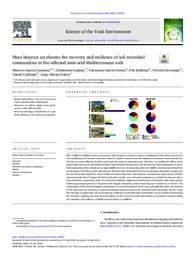Por favor, use este identificador para citar o enlazar este ítem:
https://hdl.handle.net/11000/33721Registro completo de metadatos
| Campo DC | Valor | Lengua/Idioma |
|---|---|---|
| dc.contributor.author | García-Carmona, Minerva | - |
| dc.contributor.author | Lepinay, Clémentine | - |
| dc.contributor.author | Garcia-Orenes, Fuensanta | - |
| dc.contributor.author | Baldrian, Petr | - |
| dc.contributor.author | ARCENEGUI, VICTORIA | - |
| dc.contributor.author | Cajthaml, Tomas | - |
| dc.contributor.author | Mataix-Solera, Jorge | - |
| dc.contributor.other | Departamentos de la UMH::Agroquímica y Medio Ambiente | es_ES |
| dc.date.accessioned | 2024-10-29T10:05:45Z | - |
| dc.date.available | 2024-10-29T10:05:45Z | - |
| dc.date.created | 2022-07-19 | - |
| dc.identifier.citation | Science of the Total Environment 846 (2022) 157467 | es_ES |
| dc.identifier.issn | 0048-9697 | - |
| dc.identifier.issn | 1879-1026 | - |
| dc.identifier.uri | https://hdl.handle.net/11000/33721 | - |
| dc.description.abstract | After wildfires inMediterraneanecosystems,ruderalmossesarepioneerspecies,stabilizing the soilsurface previous to the establishment of vascular vegetation. However, little is known about the implication of pioneer moss biocrusts for the recovery and resilience of soils in early post-fire stages in semi-arid areas. Therefore, we studied the effects of the burgeoning biocrust on soil physicochemical and biochemical properties and the diversity and composition of microbial communities after a moderate-to-high wildfire severity. Seven months afterthe wildfire, the biocrust softened the strong impact ofthefireinsoils, affecting thediversity and composition ofbacteriaand fungicommunitycompared to the uncrusted soils exposed to unfavourable environmental stress. Soil moisture, phosphorous, and enzyme activities representing the altered biogeochemical cycles after the fire, were the main explanatory variables for biocrust microbial community compositionunderthesemi-arid conditions. High bacterial diversity was found in soils under mosses, while long-lasting legacies are expected in the fungal community, which showed greater sensitivity to the fire. The compositionof bacterial andfungal communities atseveral taxonomical levelswas profoundly alteredbythepresence of the moss biocrust, showing a rapid successional transition toward the unburned soil community. Pioneer moss biocrust play an important role improving the resilience of soil microbial communities. In the context of increasing f ire intensity, studying the moss biocrust effects on the recovery of soils microbiome is essential to understanding the resistance and resilience of Mediterranean forests to wildfires | es_ES |
| dc.format | application/pdf | es_ES |
| dc.format.extent | 10 | es_ES |
| dc.language.iso | eng | es_ES |
| dc.publisher | Elsevier | es_ES |
| dc.rights | info:eu-repo/semantics/openAccess | es_ES |
| dc.rights | Attribution-NonCommercial-NoDerivatives 4.0 Internacional | * |
| dc.rights.uri | http://creativecommons.org/licenses/by-nc-nd/4.0/ | * |
| dc.subject | Biocrust | es_ES |
| dc.subject | Microbial community composition | es_ES |
| dc.subject | Mosses | es_ES |
| dc.subject | Post-fire management | es_ES |
| dc.subject | Wildfire | es_ES |
| dc.title | Moss biocrust accelerates the recovery and resilience of soil microbial communities in fire-affected semi-arid Mediterranean soils | es_ES |
| dc.type | info:eu-repo/semantics/article | es_ES |
| dc.relation.publisherversion | https://doi.org/10.1016/j.scitotenv.2022.157467 | es_ES |

Ver/Abrir:
1-s2.0-S004896972204565X-main-2.pdf
1,59 MB
Adobe PDF
Compartir:
 La licencia se describe como: Atribución-NonComercial-NoDerivada 4.0 Internacional.
La licencia se describe como: Atribución-NonComercial-NoDerivada 4.0 Internacional.
.png)